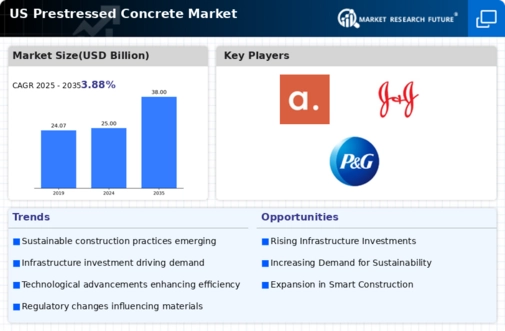Increased Focus on Safety Standards
The heightened focus on safety standards in construction is influencing the prestressed concrete market. Regulatory bodies in the US are implementing stricter guidelines to ensure the safety and reliability of infrastructure. Prestressed concrete, known for its ability to withstand extreme loads and resist cracking, is becoming a preferred material in projects that require compliance with these stringent safety regulations. The prestressed concrete market is likely to benefit from this trend, as construction firms seek materials that not only meet but exceed safety requirements. As safety becomes a paramount concern, the demand for prestressed concrete is expected to rise, particularly in high-risk applications such as bridges and high-rise buildings.
Urban Development and Housing Needs
The ongoing urban development and increasing housing needs in the US are driving the prestressed concrete market. As cities expand and populations grow, there is a pressing demand for residential and commercial buildings that can accommodate this growth. Prestressed concrete offers advantages such as reduced construction time and enhanced structural integrity, making it an attractive option for developers. In 2025, the housing market is projected to grow by 10%, leading to a corresponding increase in the demand for prestressed concrete. The prestressed concrete market is well-positioned to capitalize on this trend, as it provides solutions that meet the needs of modern urban environments while ensuring sustainability and efficiency.
Government Infrastructure Investments
Government initiatives aimed at revitalizing infrastructure are significantly impacting the prestressed concrete market. The US government has allocated substantial funding for infrastructure projects, including highways, bridges, and public transportation systems. In 2025, federal and state budgets are expected to exceed $200 billion for infrastructure improvements, creating a favorable environment for the prestressed concrete market. This influx of capital is likely to lead to increased construction activities, thereby enhancing the demand for prestressed concrete. Furthermore, the focus on sustainable infrastructure development aligns with the properties of prestressed concrete, which offers both strength and environmental benefits, making it a preferred material for government-funded projects.
Technological Innovations in Construction
Technological advancements in construction methods are reshaping the prestressed concrete market. Innovations such as advanced mixing techniques, improved curing processes, and the use of high-performance fibers are enhancing the properties of prestressed concrete. These developments allow for greater design flexibility and improved structural performance, which are crucial in modern construction. The prestressed concrete market is likely to see a surge in demand as builders and engineers adopt these technologies to meet the increasing requirements for efficiency and sustainability. As of 2025, the integration of technology in construction is expected to grow by 15%, further solidifying the role of prestressed concrete in contemporary building practices.
Rising Demand for Durable Construction Materials
The increasing emphasis on durability in construction is driving the prestressed concrete market. As infrastructure projects require materials that can withstand harsh environmental conditions, prestressed concrete emerges as a preferred choice due to its enhanced strength and longevity. In the US, the construction sector is projected to grow at a CAGR of approximately 5% from 2025 to 2030, further fueling the demand for robust materials. The prestressed concrete market benefits from this trend, as it offers solutions that reduce maintenance costs and extend the lifespan of structures. Additionally, the ability of prestressed concrete to support larger spans without intermediate supports makes it ideal for bridges and high-rise buildings, aligning with the growing need for innovative construction solutions.














Leave a Comment